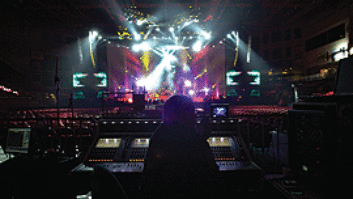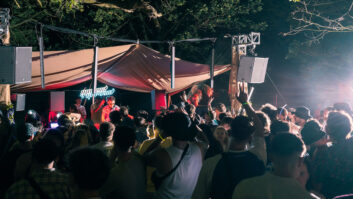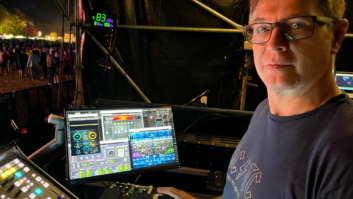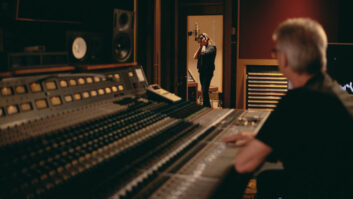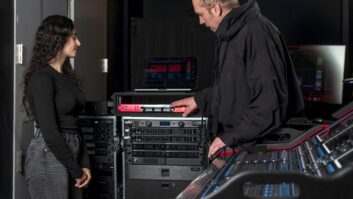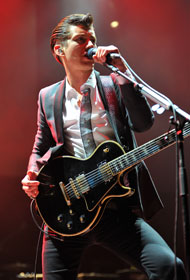
Alex Turner (vocals and guitar)
Photo: Steve Jennings
The Arctic Monkeys—Alex Turner, vocals, guitar (pictured, singing into a Sennheiser e935); Jamie Cook, guitar; Nick O’Malley, bass; Matt Helders, drums—stopped in at the Fox Theater, Oakland, Calif., in late fall 2013, where they took advantage of the Meyer Sound house P.A.
“I’m mixing on the DiGiCo SD10 with a pair of Waves SoundGrid servers and an SD-Rack,” says front-of-house engineer Matthew Kettle. “It’s a very powerful and flexible system. I especially like the way the Waves plug-in technology is integrated into the workflow of the desk. I’m also using a DiGiCo UB MADI USB interface into Logic Pro X for making archive multitrack recordings and for virtual soundchecks.

Front-of-house engineer Matthew Kettle
Photo: Steve Jennings
“I’m using quite a few Waves plug-ins, including the NLS, SSL Compressor, MPX Tape, CLA-76, Kramer PIE, H-EQ, Doubler, S1-Imager, Renaissance De-Esser, C6, REDD17, RS56 passive EQ—a recent favorite on the stereo bus—H-Delay for tape delays, IR-Live for spring and plate reverbs. I use more of the vintage gear plug-ins with Arctic Monkeys as it really suits their aesthetic. I’m currently really into the IR-Live with them, as it opens the door to so many great classic effects IRs. I deliberately try to exist without outboard gear, for purely pragmatic reasons. We do a lot of travel between continents and have to pick up local production for each leg, often with very little pre-production time. I love the simplicity of having everything contained inside the show file.”

Selmer Zodiac and Estey amp combo
Photo: Steve Jennings
Guitar tech Steve Bodie is responsible for guitarist/vocalist Alex Turner. Pictured is a Selmer Zodiac and Estey amp combo miked with a Sennheiser 906 and 421, “a classic combination blended together.”

Monitor engineer Will Doyle
Photo: Steve Jennings
“I’m mixing on a Soundcraft Vi6 for the tour,” says monitor engineer Will Doyle. “I really like the way the desk is laid out—it’s very easy to see a lot of information at the same time, which I think gives it a very analog feel. It also makes it easy to multitask, which is great for monitors. It’s possible to work on three mixes at the same time; for example, two on encoders and one on faders. There’s no having to assign graphic or parametric EQs to outputs or any nonsense like that. They’re just there to start with. One of my favorite features is having VCAs within aux sends. So if a band member wants the drums up, I can just move one fader to oblige, without affecting anyone else. I suppose the most important thing is it sounds great. The preamps are really clean, the EQ ranges from being dead subtle to very effective when you need it, the automation is easy to use and the compression sounds natural.

Matt Helders (drums)
Photo: Steve Jennings
“Everyone has Ultimate Ears UE7s and Shure PSM1000 in-ear systems,” Doyle continues, adding that Wireless Workbench makes it quick and easy to find clean frequencies. “To get a bit of air moving onstage there are also three pairs of d&b M2 wedges across the front and a stack of d&b C7 on either side as sidefills. Using wedges for the low end frees up a bit of headroom in the IEMs.

Nick O’Malley (bass)
Photo: Steve Jennings
Drummer Matt Helders’ kit is miked with a Sennheiser 901 and 902 in the kick drum (“901 for loads of attack and the 902 for body,” says FOH engineer Kettle), Beyerdynamic 201s on snare top and bottom to reduce spill, Shure SM81 on hi-hats, Sennheiser 904s on toms “because they sound great and are nearly indestructible,” and AKG 414s on over- (under)heads. “I think we nicked the idea for a 904 on drum vocals from watching the Foo Fighters,” adds monitor engineer Doyle. “Unobtrusive mics get hit less.”

Jamie Cook (guitar)
Photo: Steve Jennings
Bassist Nick O’Malley is supported by Guitar and Bass Tech Scott Gillies, and plays through a setup of a Fender Bassman 100 and Ashdown 300 amp, each miked with a Beyerdynamic M88.
Guitarist Jamie Cook’s amp setup comprises a Hiwatt and Simms- Watts 100, each miked with a Sennheiser 906 and 421, then blended together.

